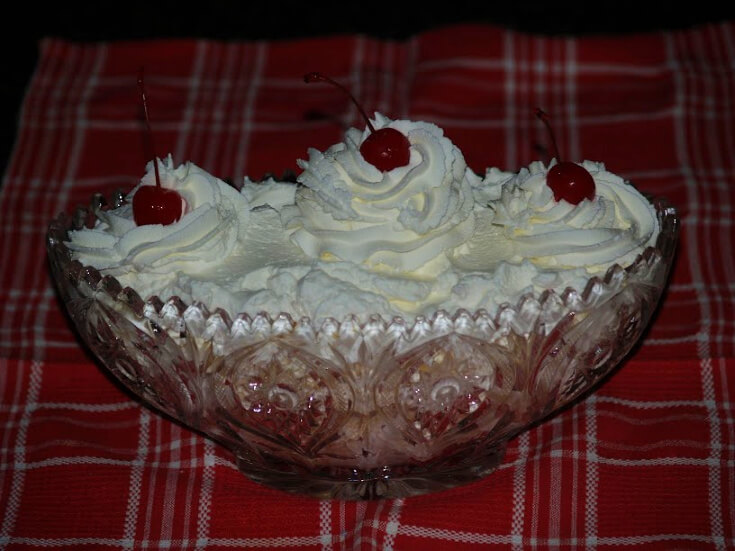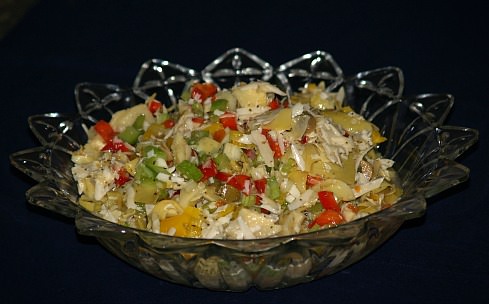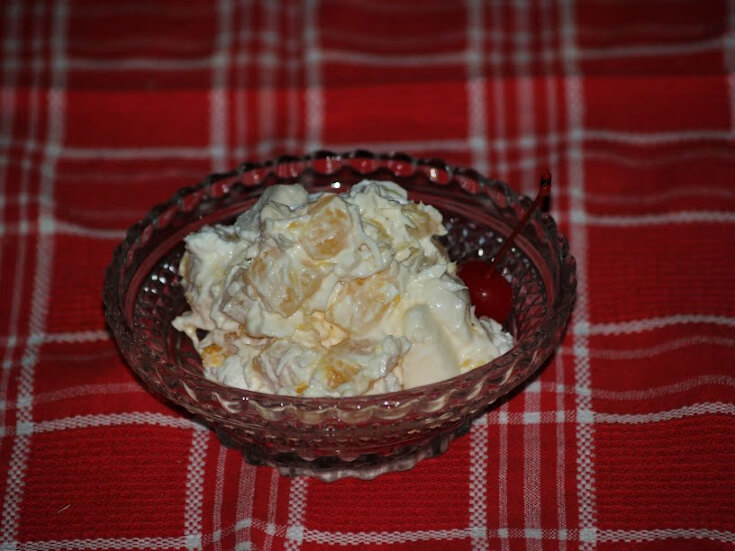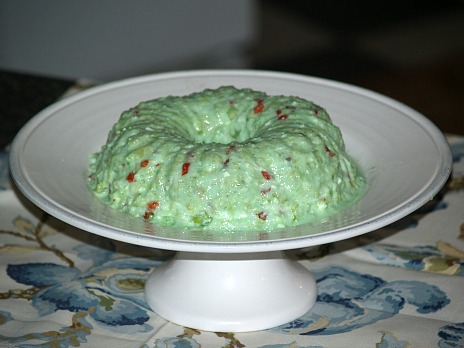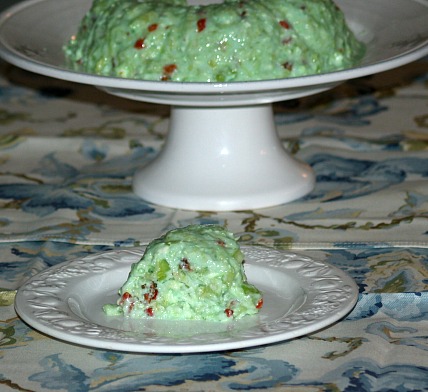- Painless Cooking
- Salads
- Favorite Salad Recipes
How to Make a Salad
If you are learning how to make a salad you must know that it is much more than a chunk of head lettuce and a spoonful of dressing poured over it. Vegetables and fruits take on a whole new dimension when served as salads. They have become increasingly popular over the years and with the greatly widened consideration of what makes a salad. A salad can open a meal or be the ending of a meal. A small salad can compliment a hearty meal or it can serve as a main course for lunch or dinner. A salad can even serve as a dessert.
When you mention how to make a salad to someone, the first thing that
comes to their mind is the many fresh crisp greens that fill our
markets. Crispy lettuce, chicory, romaine, escarole, watercress, celery,
cabbage and endive are certainly as popular as ever. Indeed the vogue
for the salad bowl has enhanced their favor. Now we are adding to these
beautiful greens, orange carrots, the red cabbages, yellow, orange and
red peppers and red tomatoes.
Salads depend more on the freshness and quality of raw ingredients
than on fancy recipes. If you know how to make a salad you know the best
recipe will turn sour with pour quality ingredients. Living in an age
when people are consumed in health and also love good food, salads have
evolved into a world of its own. No longer, especially in restaurants,
are we served a plain simple green salad. If you know how to make a
salad, each salad is a work of art containing a variety of greens plus
many other ingredients.
When learning how to make a salad, I would say let your imagination go to work. There are not many limitations placed on what ingredients can go into a salad to enhance the flavor. For many years now cooks and chefs have been adding fruit, meat, poultry cheese, fish, seafood, egg, cooked or canned fruits and vegetables and forms of breads like croutons or crackers. Often salads like the ever popular potato salad are added to a green salad to make it special. This is why salads have emerged into entre dishes for many.
When you learn how to make a salad you find that good green salads
need to have crisp greens that have been thoroughly washed, dried and
refrigerated so they crackle when you eat them. The best way to
accomplish is to wash the greens long before you intend to use them in
cold running water. If you have a salad spinning basket, remove as much
moisture as possible. If a basket is not available, drain the greens in a
clean towel. I usually place the greens in a large zip lock freezer
bag, close tightly and store in the refrigerator for about an hour
before serving.
ARTICHOKE SALAD RECIPE
- 1 Jar (16 ounces) marinated artichokes chopped
- 2 Cloves minced garlic
- ½ Chopped red bell pepper
- ½ Chopped yellow bell pepper
- 20 Green stuffed olives chopped
- 2 Tablespoons lemon juice
- 1 Cup grated Parmesan cheese
- 1 Cup chopped celery
- Salt/pepper to taste
Drain jar of artichokes saving juice; chop artichokes and put in bowl with juice.
Add remaining ingredients to the bowl; stir to blend and refrigerate until ready to serve.
AMBROSIA FRUIT SALAD RECIPE
When learning how to make a salad, you will find many like the fruit salads are delicious enough for dessert.
- 1 Cup drained mandarin oranges
- 1 Cup drained pineapple tidbits
- 3 Sliced bananas
- 1 Cup miniature marshmallows
- 1 Cup flaked coconut
- 1 Cups sour cream
- 1 Tablespoon mayonnaise
- Maraschino cherries for garnish
- Whipped cream for garnish
Combine and blend all fruit; combine and blend sour cream and mayonnaise.
Mix sour cream mixture with fruit mixture; add coconut and marshmallows.
Garnish top with whipped cream and maraschino cherries.
HOW to MAKE a SALAD with FRESH SALAD GREENS
Each season brings a new harvest of crisp greens to tempt salad lovers. Many are too intense in flavor to use alone, but add special flavor when blended with the milder varieties.
- Leaf lettuce is a favorite of home gardening. It is easy to grow in large leafy bunches. With its nice crisp and curly leaves, it goes well in salads with its great flavor.
- Oak leaf lettuce, named because it looks so much like oak leaves from the tree, has a delicate flavor. Bronze Beauty is another variety of the plant but has reddish brown leaves instead of the green.
- Head lettuce is most familiar of the lettuces to most people. It is a firm compact head of light green leaves. It is very versatile in many different salads or on sandwiches as a garnish.
- Romaine lettuce is one of my favorite lettuces because it holds up well in salads that are prepared ahead of time, such as one of my layered salads. It is more strongly flavored than many of the others. It is recognizable by its long head and spoon shaped leaves. It is coarser and crisper than most varieties.
- Boston lettuce, also known as butter head has velvety spreading leaves which can easily be removed. This is available much of the year in most supermarkets and adds greatly to your salad
- Bibb lettuce is smaller and more delicate than the Boston lettuce. This lettuce was introduced by Jack Bibb to his friends in Kentucky shortly after the Civil War. It is more expensive and not available as much as some of the other lettuces.
- Spinach is not a lettuce but the tender young leaves add wonderful taste and appearance to salads. It is known for all of its nutritional value.
- Watercress is a dark green leafy plant with a tang in the taste. It adds an interesting taste and color to a tossed green salad or looks attractive with contrasting colors as a garnish.
- Curly endive or chicory has a maze of narrow, thin , twisted leaves shaded from a dark green at the edges to a pale yellow heart. It has almost a bitter taste but makes an attractive presentation served with fruit.
- Belgian endive is a member of the chicory and escarole family but has a straight, pale, slender leaf; six inches or more in length. It can be served cut length wise or crosswise into a salad of mixed greens or it can be eaten alone. It is eaten like celery.
- Escarole taste a little like Belgian endive but not as bitter. It is often called the broadleaf endive. They are dark green edging into yellow.
- Arugula is a tender spicy, mustardy flavored green. Some varieties have smooth edged leaves and others have serrated leaves.
- Baby bok choy is milder flavored when harvested young and has a cabbage like flavor.
- Butter lettuce Notably delicate and ruffled having a faint taste of butter.
- Baby chicory More softly textured than mature chicory and has a subtly bitter flavor.
- Green cabbage is so pale that it is sometimes called white cabbage and has a firm compact head and a distinctive flavor.
- Limestone lettuce is a form of butter head and has delicate leaves that are at once soft and crisp.
- Nappa cabbage, celery cabbage or Chinese cabbage is a bit sweeter than our more familiar cabbage; has a moist crispness and a slightly zesty flavor.
- Radicchio, red chicory or Italian red lettuce with small, round or elongated heads has taste somewhat taste like escarole. The sturdy leaves range from purplish red to variegated red and green.
- Red cabbage is similar in form and flavor to the green variety and has royal purple leaves.
If you know how to make a salad you know that fruit salad recipes are an American creation and their popularity increases every year. Naturally elegant, fresh fruits are natural choices for salads. Their rich appetizing colors and flavors come forward with as little embellishments as possible. New and improved varieties of fruit and the availability of purchasing them have made ideas for fruit salad recipes endless.
A fruit salad can be as simple as cutting two or more different fruits and serving on a small plate or small bowl. Once cut, some fruits like apples, apricots, bananas, peaches and pears begin to darken as cut surfaces are exposed to the air. To prevent this color change brush cut surfaces with lemon juice.
Many learn how to make a fruit salad by adding a juice to a variety
of cut fruits. Juices like orange juice adds flavor to the cut fruits
but also prevents the fruits from turning color. Flavored gelatin can
also be helpful in making fruit salads; just prepare the gelatin and add
the cut up fruit or canned fruit. Cottage cheese is an ingredient that
lends taste to fruit salads; serve on a fruit plate or stir into salads
like the gelatin salad. If learning how to make a salad try adding
miniature marshmallows. They are great to mix into fruit salads to make
them a little special. The one ingredient that turns any ordinary fruit
salad recipe into a delicious dessert is whipped cream. Add a dollop to a
fruit plate or stir some into a bowl of gelatin fruit salad and you
have a dessert you are proud to serve.
If learning how to make a salad you will learn that just because it is a salad it does not have to be green and leafy or be made from fruit. Seafood salad recipes, meat salads and pasta salad recipes can become versatile appetizers, first courses or suitable entrees. When it is too hot to cook, build a delicious salad from cold turkey, chicken, beef, shrimp or crab. Hot salads can be prepared as a sizzling stir fry served over crisp lettuce bed.
When learning how to make a salad, don’t forget all the rice, pasta
and whole grain salads. These salad recipes have taken on a class of
their own. They now boast of a variety of fresh ingredients creating
intriguing combinations in taste and eye appeal. Many of these salads
like Tabbuli and couscous salads derive their unique flavor from other
countries. As I have said before, being the melting pot that we are here
in the United States, we can enjoy the best flavors from around the
world. This is also true in the “salad world”.
COTTAGE CHEESE SALAD RECIPE
Learn how to make a salad with Jell-O; it is amazing the different ones with so many flavors can be made.
- 1 Package lime Jell-O
- 1 ½ Cups boiling water
- ½ Cup pineapple juice
- 1 Cup cottage cheese
- ¼ Teaspoon salt
- ½ Cup mayonnaise
- 1 Tablespoon vinegar
- 1 Cup crushed pineapple well drained
- 1 ½ Cups diced celery
- ¼ Cup pimiento drained
- ¼ Cup chopped nuts
Dissolve Jell-O in water by stirring; add pineapple juice.
Cool to slightly thickened then whip with beaters; add remaining ingredients and chill.
